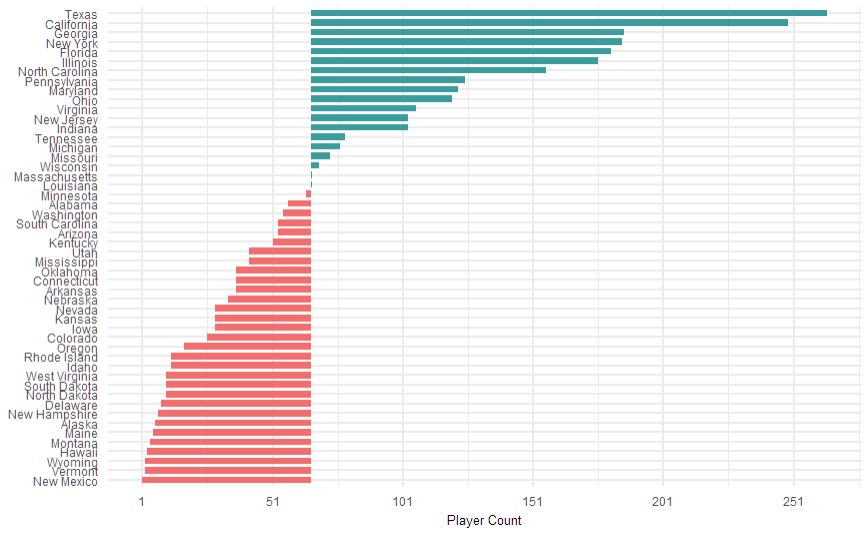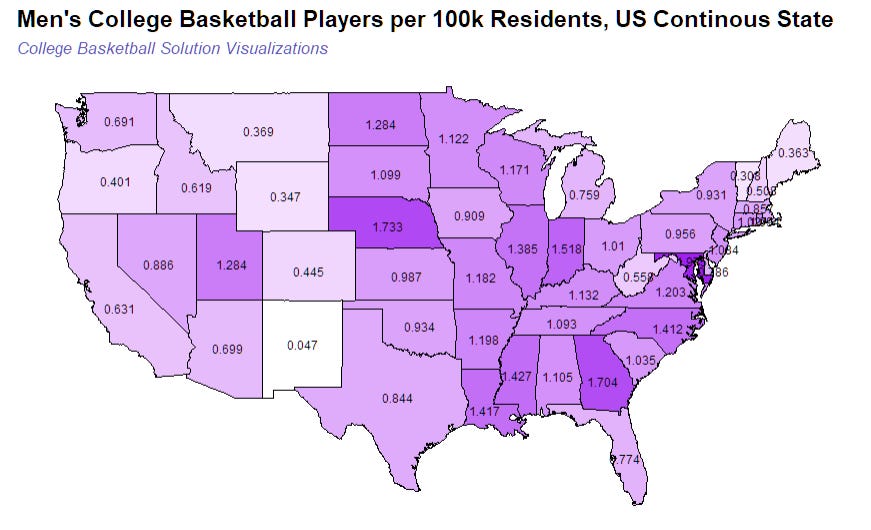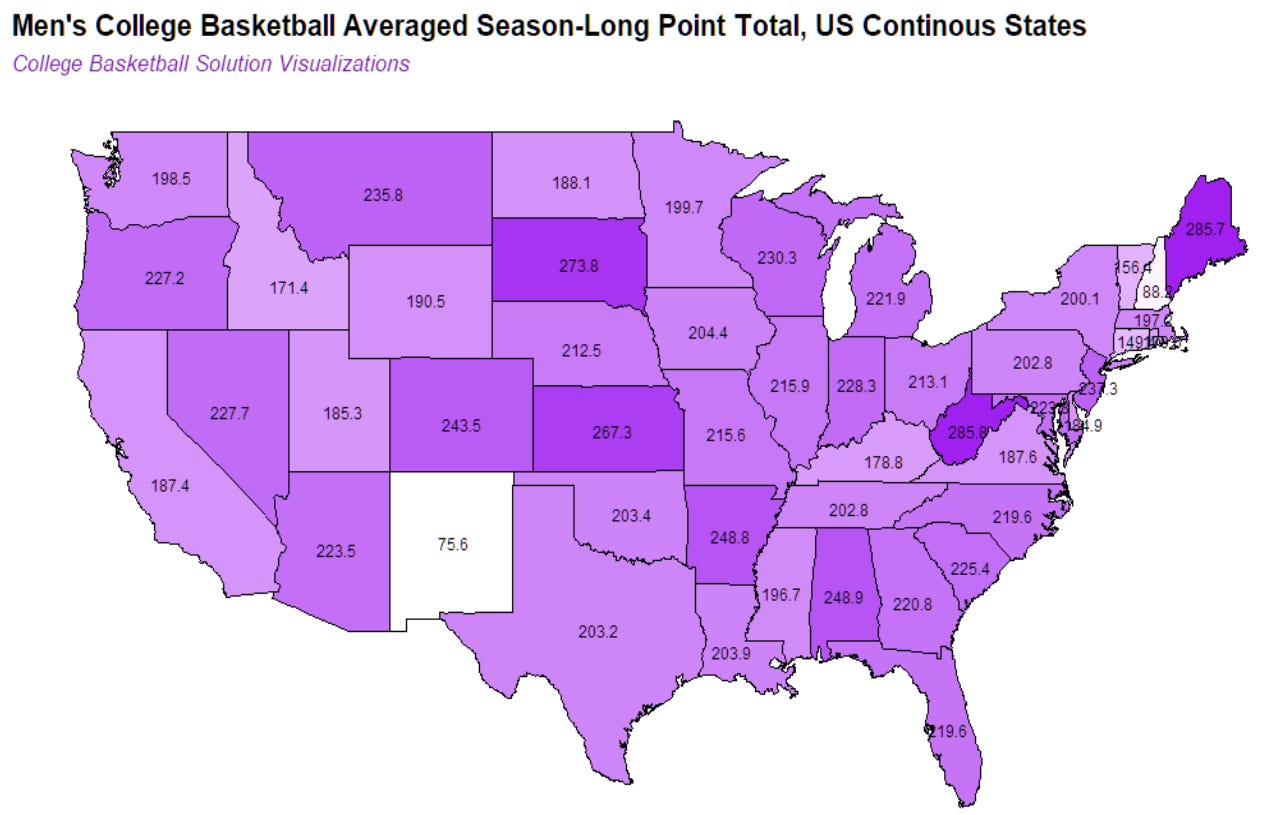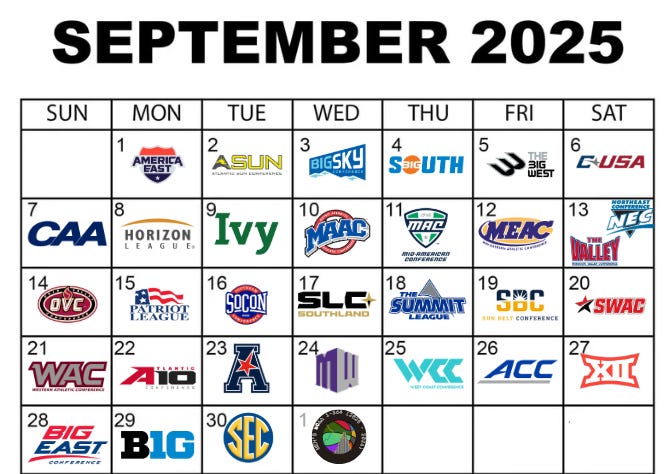A Topical Look at State-by-State College Basketball Production in the U.S.
Plus a discussion of 1-364 plans
Unsurprisingly, basketball is most accessible to high schoolers in warm, densely populated states. California, Texas, and Georgia alone accounted for 21% of men's college basketball players last season.
By scraping data from College Basketball Reference, which includes hometown information for most players, we get a clearer picture of where talent comes from across the country. While the data is incomplete, and omits lower-usage players, it still offers a unique look at where production originates.
Several low-population states produced few players. Nine states had fewer than 10, including much of New England, Alaska, Hawaii, and others in the West.
This reflects population size more than the actual talent level in each state.
Looking at basketball production relative to state population gives a clearer view of which places stand out. The states with the most college basketball players per 100,000 residents: Maryland (1.975, though hard to see on the map due to density), Nebraska, and Georgia—lead the way.
Nebraska and Indiana are especially notable, considering their colder winters and limited daylight hours, which make year-round outdoor play difficult.
New Mexico stands out for having just one reported player across its 2.1 million residents. Other states with very low production include those near the bottom of the list, such as Cooper Flagg’s Maine.
While Georgia ranks third in total player count and aligns closely with its per-capita average, California and Texas, first and second in total numbers, fall well below the national average of 0.97 college basketball players per 100,000 residents.
State of Shadows
While certain factors may make some states more likely to produce college basketball players, what other stories might the data reveal? More of the same. Looking at the average height in each state shows again how small sample sizes can lead to misleading conclusions.
Mississippi stands out again. With an average height below 6'4½", it was the second shortest state.
Focusing on season-long productivity, we can see which states had the highest average point production per player. Despite having only 10 players, West Virginia showed few weaknesses. Virginia’s Isaac McKneely and Marshall’s Obinna Anochili-Killen led the way by playing in many games and scoring consistently. Cooper Flagg lifts Maine to the second highest point production per player.
Nebraska, a strong per-capita basketball state, shines again. Monmouth’s Abdi Bashir and Wisconsin’s John Tonje averaged over 20 points per game, boosting the Cornhusker State.
New Mexico and New Hampshire are on the lower end of statewide point production, largely due to the low sample size.
Under Stars
What is college basketball without healthy, hypothetical competition? To create a hypothetical all-star game based on players' home states, the following equation was developed to identify the most productive players for this inter-state showcase. It factors in flashy counting stats while penalizing inefficiencies like turnovers and poor shooting, reflecting a roster built with the casual fan in mind.
In filling out all-star rosters, players with at least 20 games played were included in the formula above. Starting fives were filled as quickly as possible for each state. The two states able to complete their starting five first, based on the composite score, are featured in this hypothetical matchup.
Surprisingly, New Jersey had four players in the top 20 of this statistic, with all five starters ranking in the top 50.
Yaxel Lendenborg was likely the most productive player in the country last season based on raw box score statistics, leading UAB in every category. He is from Pennsauken, New Jersey. Another lesser-known but efficient scorer and strong rebounder, Rafael Castro, was also a high scorer. The final three players were all drafted in the top 32 of the most recent NBA Draft.
Two Georgetown players make this list, with Peavy combining assists and steals to offset his below-average true shooting. JT Toppin is no surprise, an All-American from Dallas. Tayton Conerway is a better-known mid-major star, the Sun Belt Player of the Year who led his Troy to the NCAA tournament.
While New Jersey may have stronger individual talent, none of its teams came close to the NCAA tournament this season. Micah Peavy is the only native Texan who didn’t make the NCAA Tournament.
In the end, this hypothetical matchup between the states with the best top-tier talent could go either way. As always, this is just an exercise.
-BM
Programing Update (1-364)
We're entering the fourth year of ranking every college basketball team ahead of the season. In previous years, I've either crammed all 360+ teams into a single post or split them into several. Last season's preview required the latter because of the sheer volume. The Google Sheet spanned 405 pages and 112,000 words, far too much for a single Substack post.
This year, a more digestible format was chosen without sacrificing the depth of information provided for every team’s preview. As announced earlier this month, the project will launch on September 1.
This marks the first of 31 consecutive daily posts, with each day dedicated to previewing one conference. The series will conclude with a comprehensive national ranking that places all 364 teams in context. Each team's synopsis will be concise enough to fit within a single Substack post.
The rollout will begin with the single-bid conferences, move through the competitive mid-majors, and wrap up with the high majors. By the end, every team in the country will have been covered.
Above is the release schedule for the month, outlining when each preview will go live. The plan is to publish a new preview each day at 8 AM ET, though that timing may shift depending on the demands of the project.














